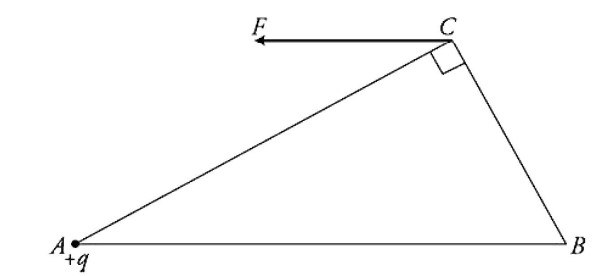Question

Two spheres are separated by a distance d. The first sphere has a known positive charge. The second sphere has a charge of a magnitude greater than the magnitude of the charge on the first sphere but unknown sign. Given this information, at which two of the above locations could a positive test charge potentially experience 0 net electrical force? Select two answers.
(A) A
(B) B
(C) C
(D) D
▶️Answer/Explanation
Ans:A, B
First, assume the second charge is positive. If this is the case, both charges will repel the positive test charge. For two repelling forces to cancel out, the test charge must be between the two spheres. Additionally, because \(F_{e}=kq_{1}kq_{2}/r^{2}\), the test charge must be closer to the left-hand sphere to counteract the greater magnitude of charge on the right-hand sphere. Thus, location B would be acceptable for this situation.
Next, assume the second charge is negative. If this is the case, placing the positive test charge anywhere between the two spheres would result in a net force to the right since the electric force from each sphere would be in that direction. That leaves only location A as an acceptable answer in this situation.
Question
Two electrons exert an electrostatic repulsive force on each other. Is it possible to arrange the two electrons so the gravitational attraction between them is large enough to cancel out the electric repulsive force?
(A) No, the charge of the electrons squared is much larger than the mass of the electrons squared.
(B) No, there is no gravitational force between subatomic particles.
( C) Yes, reducing the radius between the electrons will increase the gravitational force as it is proportional to the inverse of the radius squared.
(D) Yes, increasing the distance between the electrons will reduce the electrostatic repulsion until it is equal to the gravitational force.
▶️Answer/Explanation
Ans:
A
Gravity is proportional to the product of the two masses, and the electric force is proportional to the product of the two charges. Since the mass of an electron is on the order of \(10^{-31}\) kg, and the charge is on the order of \(10^{-19}\) C, the electric force will be much larger than the gravitational force. In addition, the universal gravitational constant is much smaller than the Coulomb’s law constant. This makes the gravitational force between the electrons negligible compared to the electric force.
Question

The metal spheres on insulating stands 1, 2, and 3 are all identical and situated as shown in the figure. Spheres 1 and 2 have a charge of -Q, and sphere 3 has a charge of +2Q. The force of sphere 1 on sphere 2 is +F. What is the magnitude of the net force on sphere 3 in terms of F?
(A) 3/2 F
(B) 2 F
(C) 5/2 F
(D) 3 F
▶️Answer/Explanation
Ans:
C
The force from sphere 1 on sphere 3 is ½ F to the left. The force from sphere 2 on sphere 3 is 2F to the left. The sum is ( 5/2) F.
Question
The news reports the discovery of two new particles by the research facility CERN in Geneva. The first particle, dubbed Alithisium, is large with a mass equivalence of 125 GeV ± 15 GeV and a net charge of – 1.55 x \(10^{-18}\) C ± 0.1 x 10-18. The second particle, Psevdisium, has a mass of 5.4 x \(10^{-4}\) u ± 0.1 x \(10^{-4}\) u and a charge of 1.6 x \(10^{-20}\)° C ± 0.5 x \(10^{-20}\). Which of the following is most correct concerning the two new particles?
(A) Both particles appear reasonable.
(B) Alithisium appears reasonable, but Psevdisium does not.
(C) Psevdisium appears reasonable, but Alithisium does not.
(D) Neither particle appears reasonable.
▶️Answer/Explanation
Ans:
B
The charge of Psevdisium is smaller than the electron charge, which calls this particle’s existence into doubt. Within the level of uncertainly listed, the charge of Alithisium is ten times the charge of the electron. We would expect the charge to be a whole integer multiple of the electron charge. The mass of Alithisium is listed as an energy equivalent. This is perfectly acceptable: \(E=mc^{2}\)
Question

A positive charge ( +q) is placed at vertex A of a triangle, as shown in the diagram. What charge must be placed at vertex B to cause an electron placed at vertex C to receive a force as shown?
(A) Positive and smaller than \(\left| +q \right|\)
(B) Positive and larger than \(\left| +q \right|\)
(C) Negative and smaller than \(\left| +q \right|\)
(D) Negative and larger than \(\left| +q \right|\)
▶️Answer/Explanation
Ans:C
For the electron to receive a force to the left, the electric field must be pointing to the right. The electric field from the charge at vertex B must be smaller in magnitude than the field produced by the charge at vertex A. To accomplish this, the charge at point B must be negative and smaller than\(\left| +q \right|\).

